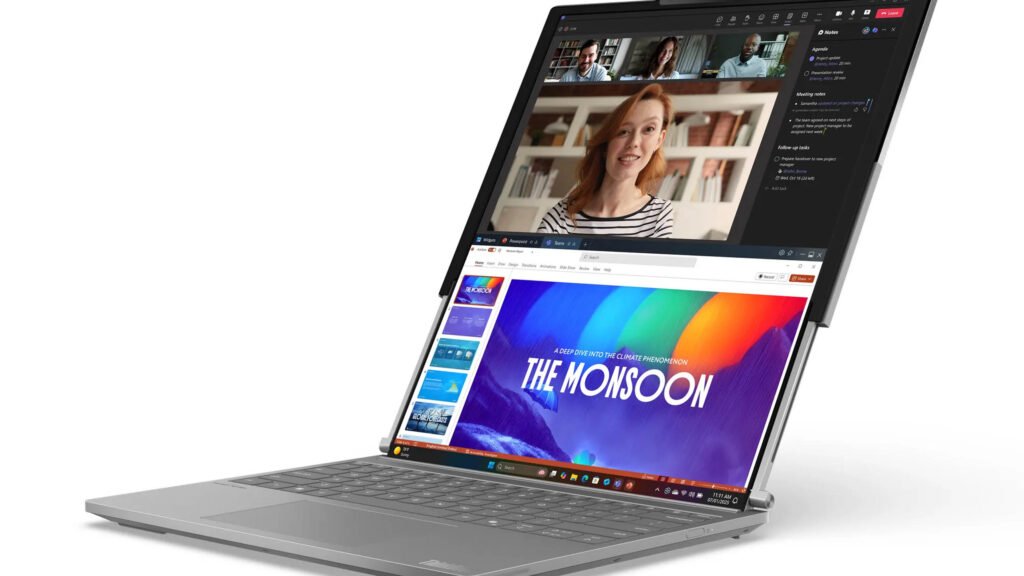LENOVO:
The ThinkBook Plus Gen 6 is more than just a concept—it’s a real laptop you’ll soon be able to buy. For me, Lenovo’s ThinkBook Plus Gen 6 was the standout at CES. The moment I pressed a button on the keyboard and watched the rollable OLED display extend upward, motors whirring, a big grin spread across my face.
Amid Lenovo’s numerous CES announcements, including laptops, desktops, gadgets, and handhelds, the ThinkBook stands out as both innovative and unconventional. Priced at $3,499, it’s set to launch in Q1 2025. While the price is steep and its design quirky, there’s something delightful about owning such a unique device for tasks like tackling tall spreadsheets.
:format(webp)/cdn.vox-cdn.com/uploads/chorus_asset/file/25820495/247466_CES_2025_Lenovo_ThinkBook_Plus_Gen6_rollable_laptop_ADiBenedetto_0005.jpg)
The ThinkBook Plus Gen 6 features a flexible OLED display with small motors integrated into its hinge to extend and retract the screen. By default, it appears to be a standard 14-inch productivity laptop with a slightly square aspect ratio and a resolution of 2000 x 1600. However, pressing a dedicated key or raising your hand triggers the motors, expanding the display to an impressive 16.7 inches with a resolution of 2000 x 2350. The transition takes about 10 seconds. While the motors aren’t overly loud, they’re noticeable enough to attract attention—especially since the laptop literally grows in front of you. The extended screen space is perfect for stacking two 16:9 windows vertically.
ThinkBook Plus Gen 6:
When retracted to its 14-inch mode, the screen’s lower section hides beneath the keyboard deck, conserving power by displaying black pixels. Lenovo representatives, including Samuel Shang from the research team, explained that the screen’s nested design and compact motors allow for a robust 66Wh battery, typical for a laptop of this size. The device is rated for at least 30,000 lid openings and closings, and 20,000 screen rolls, ensuring durability.
The screen’s roll-up and roll-down motions are surprisingly engaging. By default, the laptop plays an animated graphic of a flexible material rolling as the screen adjusts, reminiscent of rolling dough through a pasta machine. This animation can be disabled, allowing you to focus on the content onscreen. While the display features some visible creases, especially in darker settings or from steep angles, they’re not particularly distracting during normal use.
:format(webp)/cdn.vox-cdn.com/uploads/chorus_asset/file/25820494/247466_CES_2025_Lenovo_ThinkBook_Plus_Gen6_rollable_laptop_ADiBenedetto_0004.jpg)
Lenovo’s ThinkBook:
The ThinkBook Plus uses Samsung Display’s IT foldable panel, similar to those found in foldable smartphones. Despite the potential fragility of its flexible OLED, Lenovo’s team seemed confident in its durability, letting me handle the laptop without special precautions. Even after jamming it into a backpack or closing the lid with the screen extended—creating a comical overbite—everything worked as intended.
In terms of standard specs, the ThinkBook is a slim, lightweight productivity machine. Configurations include up to an Intel Core Ultra 7 Series processor, 1TB SSD, and 32GB of DDR5x RAM. However, its port selection is limited to two Thunderbolt 4 ports and a 3.5mm headphone jack, meaning you’ll likely need dongles for USB-A or card readers.
Oddly, it lacks HDMI-out support, as Lenovo designed the extended screen to function as a second monitor in Windows. This workaround highlights a significant limitation: Microsoft’s OS currently doesn’t natively support rollable displays, forcing reliance on Lenovo’s software. Unfortunately, snapping windows to the bottom half of the extended screen isn’t possible—you must manually pin them using Lenovo’s app. Until Windows adds native support for rollable displays, these quirks may hinder the ThinkBook’s usability.
:format(webp)/cdn.vox-cdn.com/uploads/chorus_asset/file/25820497/247466_CES_2025_Lenovo_ThinkBook_Plus_Gen6_rollable_laptop_ADiBenedetto_0007.jpg)
Despite the potential software challenges, I’m thrilled to see the ThinkBook Plus Gen 6 become a reality. However, its long-term viability will depend on whether these software limitations can be addressed. I’m eager to see what living with a rollable laptop truly feels like over time.



